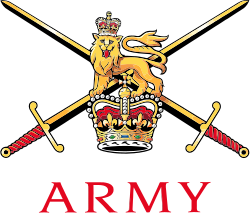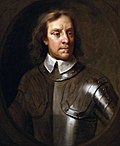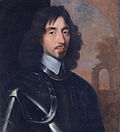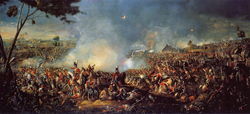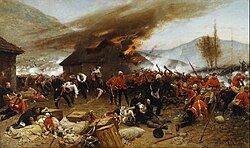British Army

The British Army is the army of the British Armed Forces, the military of the United Kingdom. The British Army came into being with unification of the Kingdoms of England and Scotland into the Kingdom of Great Britain in 1707.[1][2] The new British Army included regiments that had already existed in England and Scotland and was administered by the War Office from London. Since 1963, it has been managed by the Ministry of Defence. Around a quarter of soldiers in the British Army are in the Infantry.[3]
Under Oliver Cromwell, the English Army was active in the conquest and settlement of Ireland since the 1650s. The Cromwellian campaign was characterised by its uncompromising treatment of Irish towns that had supported the Royalists during the English Civil War.
Since the Seven Years' War ebded in 1763, the British have been one of the leading military and economic powers of the world. The British Empire expanded to include colonies, protectorates, and dominions throughout the Americas, Africa, Asia and Australasia. Although the Royal Navy is widely regarded as having been vital for the rise of the empire and British dominance of the world, the British Army also played important roles in colonisation.
The British Army was heavily involved in the Napoleonic Wars by serving in Spain and the rest of Europe and in North Africa. The war between the British and the French Empires stretched around the world. The British Army finally came to defeat Napoleon at one of Britain's greatest military victories at the Battle of Waterloo.
British Army Media
John Churchill, 1st Duke of Marlborough, was one of the first generals in the new British Army and fought in the War of the Spanish Succession. He was a noted ancestor of Sir Winston S. Churchill, later famous Prime Minister during World War II.
The Duke of Wellington and Field Marshal von Blücher's triumph over Napoleon Bonaparte at the Battle of Waterloo
In the 1879 Battle of Rorke's Drift, a small British force repelled an attack by overwhelming Zulu forces; eleven Victoria Crosses were awarded for its defence.
References
- ↑ Template:Cite ODNB
- ↑ Sheffield, Gary (2001). "British army". In Holmes, Richard; Singleton, Charles; Jones, Spencer (eds.). The Oxford Companion to Military History. Oxford University Press. doi:10.1093/acref/9780198606963.001.0001. ISBN 978-0-19-860696-3.
- ↑ Dunlop, Tom (2022-01-10). "How many soldiers are in each British Army regiment?". Retrieved 2023-02-03.
Other websites
| Wikimedia Commons has media related to Lua error in Module:Commons_link at line 62: attempt to index field 'wikibase' (a nil value).. |

